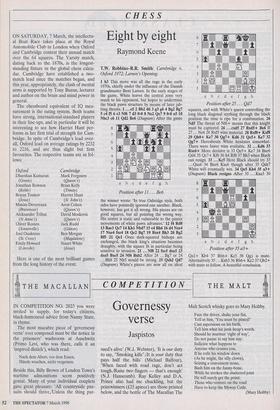CHESS
Eight by eight
Raymond Keene
ON SATURDAY, 7 March, the intellectu- al Boat Race takes place at the Royal Automobile Club in London when Oxford and Cambridge contest their annual match over the 64 squares. The Varsity match, dating back to the 1870s, is the longest- standing fixture in the global chess calen- dar. Cambridge have established a two- match lead since the matches began, and this year, appropriately, the clash of mental arms is supported by Tony Buzan, lecturer and author on the brain and mind power in general.
The chessboard equivalent of IQ mea- surement is the rating system. Both teams have strong, international-standard players in their line-ups, and in particular it will be interesting to see how Harriet Hunt per- forms in her first trial of strength for Cam- bridge. In spite of Cambridge's lead over- all, Oxford lead on average ratings by 2232 to 2216, and are thus slight but firm favourites. The respective teams are as fol- lows: Oxford Cambridge
Dharshan Kumaran Mark Ferguson (Green) (Queen's) Jonathan Rowson Brian Kelly (Keble) (Trinity) Boyan Tonkov Harriet Hunt (Jesus) (St John's) Maxim Devereaux Aron Cohen
(Brasenose) (Queen's)
Aleksander Trifun David Moskovic
(St Anne's) (Queen's) Oliver Rosten Jack Rudd
(Somerville) (Girton) Joel Ouaknine Ben Morgan (St. Cross) (Magdalene) Emily Howard Stuart White (Lincoln) (Jesus)
Here is one of the most brilliant games from the long history of the event. T.W. Robbins–R.R. Smith: Cambridge v. Oxford 1972; Larsen's Opening.
1 b3 This move was all the rage in the early 1970s, chiefly under the influence of the Danish grandmaster Bent Larsen. In the early stages of the game, White leaves the central zone very much to his opponent, but hopes to undermine the black pawn structure by means of later jab- bing thrusts. 1 ... e5 2 Bbl d6 3 g3 g6 4 Bg2 Bg7 5 c4 f5 6 e3 Nf6 7 d3 0-0 8 Ne2 Qe7 9 0-0 a5 10 Nbc3 c6 11 Qd2 Be6 (Diagram) After the game the winner wrote: 'In true Oxbridge style, both sides have pointedly ignored one another. Black, however, has got it all wrong. His pieces are on good squares, but all pointing the wrong way. His centre is static and vulnerable to the pincer movements of white pawn advances.' 12 f4 Rd8 13 Rael Qc7 14 Khl Nbd7 15 e4 Bh6 16 d4 Nxe4 17 Nxe4 fxe4 18 Qc2 Bg7 19 Bxe4 Bh3 20 Bg2 Bf5 21 Qcl Once dark-squared bishops are exchanged, the black king's situation becomes draughty, with the square f6 in particular being sensitive to invasion. 21 ...N18 22 fxe5 dxe5 23 dxe5 BxeS 24 Nf4 Bxb2 After 24 ... Bg7 or 24 ...Bh8 25 Nh5 would be strong. 25 Qxb2 Qd7 (Diagram) White's pieces are now all on ideal squares, and with White's queen controlling the long black diagonal scything through the black position the time is ripe for a combination. 26 Nd5 The threat of Nf6+ means that this knight must be captured. 26 ... cxd5 27 BxdS+ Be6 If 27 ...Ne6 28 Rxf5 wins material. 28 RxfS+ Kxf8 29 Qh8+ Ke7 30 Qg7+ Kd6 31 Qe5+ Ke7 32 Qg7+ Hereabouts White hesitates somewhat. There were faster wins available. 32 ...Kd6 33 Rxe6+ More decisive is 33 Qe5+ Ke7 34 Bxe6 Qd4 35 Qc7+ Kf6 36 h4 Rf8 37 Bh3 when Black can resign. 33 ...Kc5 Here Black should try 33 Qxe6 34 Bxe6 1Cxe6 though after 35 Qxh7 White will eventually win. 34 Qe5 Kb4 35 a3+ (Diagram) Black resigns After 35 ...Kxa3 36
Qal + Kb4 37 Rb6+ Kc5 38 Qgl is mate. Alternatively 35 ... Kxb3 36 Rb6+ Kc2 37 Qb2+ with mate to follow. A beautiful conclusion.


























































 Previous page
Previous page